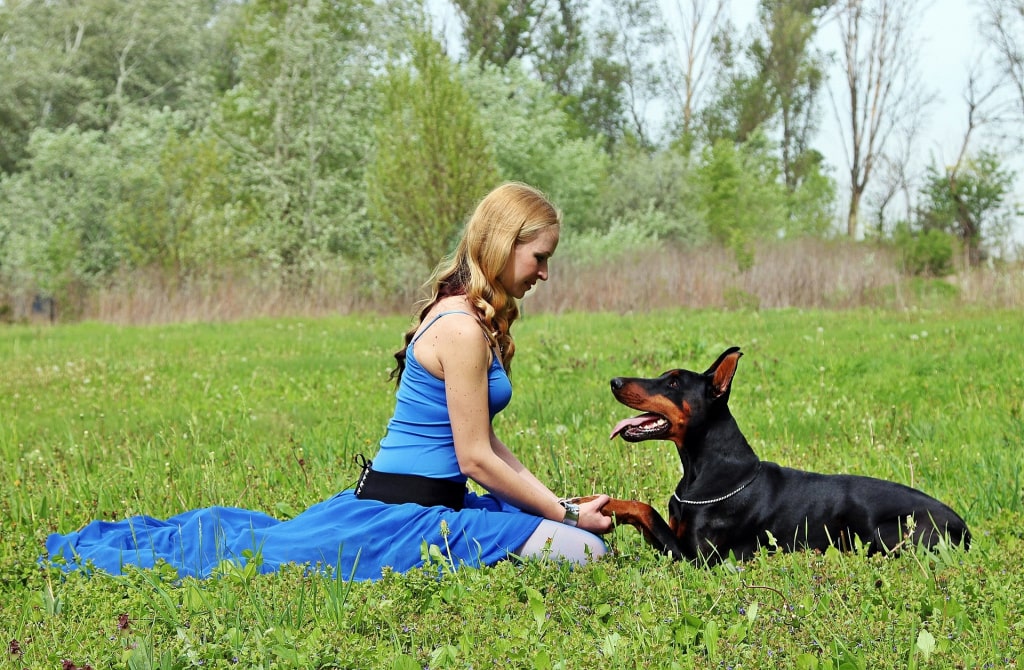As teaching a dog the “Down” command is not difficult, owners usually teach it to their puppies among the first commands. It is practical and is included in the list of mandatory skills in dog training courses.
The “Down!” command is one of the basic skills that a dog should master when going through a general training course. It is periodically used in everyday life and is of great importance. The ability of a dog to lie down on command can be used at the veterinarian’s office, when transporting the dog on public transportation, and in other situations. Moreover, it forms the basis for other, more complex commands.
What is the purpose of the “Down” command?
Despite the fact that the “Down” command is not used as often, every well-behaved dog should know it. The “Down” command is considered one of the basic commands for a puppy, and most breeds learn it fairly quickly. Where can it come in handy?
In everyday life.
Teaching your dog to “Down” on command will come in handy for you and your pet in public transportation, such as a train. This skill is appropriate in any situation where your pet needs to stop being active. Additionally, the “Down” command is included in all disciplinary training courses and in almost all dog sports.
Putting your dog down helps to keep them in a calm position and leave them in that position for a certain amount of time if necessary. This makes grooming, nail trimming, teeth cleaning, brushing, and other hygiene procedures easier.
Standard.
Passing the standards at the end of the dog training courses and further participation in competitions involves demonstrating the execution of commands. No matter what type of standard dog training you are engaged in and what sport you choose, unconditional obedience is the foundation everywhere. Therefore, the “Down” command is included in all standard dog training courses. The down position is mainly used to fix the dog in place.
When to start training?
It is better to start training your puppy from the age of three months. It is important that the puppy listens to all family members – this will avoid problems with hierarchy in the future.
If all family members plan to train the puppy, they should do it according to the same scheme (i.e. the same way). This will make it easier for the puppy to understand what is expected of him.
Just like when teaching the “Sit!” and “Stand!” commands, food motivation or contrast training (mechanical impact + encouragement) is used when teaching the “Lie down!” command. The mechanical impact in this case is pressing on the withers or a gentle push, and the encouragement is a treat, praise, and petting.
During successful training, the pet should quickly lie down from any position. It is better to start training the “Lie down!” command in combination with the “Stand – Lie down” sequence, which is related to the physiology of dogs.
Strangers should never give treats to either a puppy or an adult dog. This behavior should be discouraged immediately (for example, by redirecting the dog’s attention to the owner). However, it is okay for a puppy to play with other people.
Basic recommendations and rules.
Independent dog training will require certain preparation from the owner. You need to feel firmness in yourself and take responsibility for the animal that will trust you unconditionally. Remember that the main principle of any training is systematic and consistent.
It is not allowed to punish or scold the pet: training should take place in a friendly atmosphere. The person should be a leader, not a despot. During training, the puppy not only learns skills but also forms a connection with the owner and lays the foundation for hierarchy building.
The training process is built sequentially and correctly from the very beginning; otherwise, you will have to retrain your pet, which is much more difficult. It is important for the dog to understand that it is required not just to lie down but to remain in a lying position until the owner gives a new command.
It is necessary to choose the right place and time for training. The dog should feel good, be rested, and moderately hungry. A full or tired animal does not have the proper level of motivation to work.
Do not train for too long – choose the optimal time for your dog (based on breed, age, temperament, and other characteristics of the pet). The session should not be monotonous, otherwise, the dog will quickly get bored. Training should be interspersed with active breaks.
The process will be more successful if you follow the advice of experienced dog trainers. The most important of these are:
- If the dog has changed position without your command, it should be returned to the starting position and encouraged to perform the command.
- The duration of the stay command should be increased gradually and not rushed.
- The main thing is not quantity, but quality. If you repeat the exercise 10 times in 10 minutes, it is unlikely to give good results. It is better to perform the exercise once, but carefully monitor the quality of its execution, the correct position of the pet, and its duration.
- The ‘Go for a walk’ command should be used to cancel previous commands. If there is no cancellation command, the dog will not understand when it is allowed to change position and when it should continue to perform the previous command.
Training of stubborn breeds and breeds that are more difficult to train is recommended to be comprehensive, including behavior correction. During training, the instructor helps the owner to establish the correct system of interaction, teaches them to understand the dog, and correct its behavior properly. In complex cases, if necessary, the instructor corrects the dog’s behavior themselves, and then involves the owner in the work.
What will be needed for training?
Before starting to learn something new, you need to prepare everything you need. This is not difficult, as only the most common tools will be needed.
- Comfortable collar. This is a mandatory item – it is used to control the pet.
- Short leash (2-3 m). It will be needed not only for training, but also for moving to the training area.
- Treat. Tasty pieces should not be too big, otherwise the pet will quickly become satiated and lose interest in training.
- Good mood. This is a very important factor, as dogs are very sensitive to their owner’s emotional state. Only in a calm and friendly environment can you achieve a positive result.
If you are exercising outdoors, bring a couple of toys – they will come in handy to entertain your pet after the workout.

Where to conduct training?
The ‘Lie down’ command, like any other command, requires the dog’s attention and concentration. Therefore, training can begin as soon as the pet gets used to the new home.
Training can be done at home or outside. The main thing is to choose a calm and quiet place where the dog will not be distracted by outside noises and other animals.
The place should be clean, protected from drafts, and warm. Because it will be uncomfortable for the animal to lie on a dirty and damp surface. It is better to choose dry soil or any indoor space.
To execute the “Lie down” command, the pet will not need to move much: on the contrary, it will perform exercises in one place. Most owners train their pet to lay down skill within the walls of their own home.
How to teach a dog the “Lie down” command?
There are several ways to teach a dog the “Lie down!” command. The chosen method can be changed during training depending on the dog’s behavior. The reward-based and contrast methods of training are the most optimal during training, but they are selected individually for each dog.
The treat-based method.
The simplest and most effective method. Of course, there are breeds that have a strong play motivation (for example, Belgian Shepherds, most Staffies), and they will prefer play to treats. But when working with play motivation, the owner needs to work quickly and clearly (the toy needs to be given at a certain moment for a certain amount of time, combining it with commands and corrections in case of mistakes). Therefore, dog owners with little experience choose motivation with treats.
How training sessions using treats work:
- The trainer holds the leash in his hands, the dog is at the left leg or in front of the trainer – this is the most convenient for the person.
- We need to show the pet a treat, to interest him. Then we should clearly say “Lie down!” and slowly move the hand with the reward forward and down so that he reaches for the hand.
- Make sure the leash is loose during training. A dog that constantly feels tension on the leash becomes accustomed to the feeling of being controlled, and when the clip is unfastened, the feeling of control disappears, along with obedience. It is recommended to work with the dog only on a loose leash with minimal mechanical impact.
- Apply slight pressure to the withers to make the pet lie down completely. As soon as the dog lies down, immediately give a treat, praise it with your voice, and release it with the command “Walk”.
- If the dog doesn’t lie down for a long time, you can gently press on its shoulder blades (IMPORTANT: never put pressure on the spine!). As soon as the pet resumes laying down, immediately stop the pressure and don’t forget to reward the animal after laying down.
- It is important that the treat is given to the pet and consumed while in a lying position. If the pet stands up before consuming the treat, indicate its behavior with a negative marker (such as the word “No”), repeat the command, and reward it for completing it.
- At the first training sessions, the pet can be held in a lying position for 2-3 seconds, and then give the command “Walk!”.
The skill needs to be practiced. Repeat the exercise several times, alternating between training and rest breaks. If you are training outdoors, return home and try to repeat the command within familiar surroundings to solidify its “universality”.
Mechanical method (without treats).
This method involves using mechanical pressure on the pet with the help of a leash. It is designed for animals that know the “Down” command but are reluctant to perform it. Teaching a dog the “Down” command according to this method goes as follows:
- Put a leash on your pet.
- Place one hand on the dog’s withers and take hold of the leash with the other.
- Start by pressing down on the withers and pulling the leash down and forward simultaneously.
- Don’t forget about positive reinforcement: as soon as you achieve the execution of the command, you should immediately stop the impact on the dog, reward it with a treat, pat it and praise it with your voice.
Be careful: do not jerk your pet and make sure that it does not fall on its side, and its paws are carefully stretched forward. This is necessary so that the pet does not get injured.
With an undercut.
You can try to conduct training according to a different scenario. In this case, the trainer’s left hand is located on the dog’s withers, and the right hand picks up the pet’s front paws.
After the command “Down”, you need to carefully press on the withers and move the dog’s front paws forward with your right hand (this is called an undercut). When the dog takes a lying position, it should be praised and rewarded. After a short pause in a lying position, the pet is released with the command “Walk!”.
It is important to immediately correct the dog’s position when it performs the command. The body should be positioned in a straight line without leaning to the side. The front paws are stretched forward, the hind legs are tucked. Puppies are allowed to lean to the side and have an uneven position, which is associated with underdeveloped coordination of movements.
Using a gesture.
When the pet starts to perform the command well, it is worth adding gestures to the word “Lie”. Over time, the animal will learn to perform the action based on the gesture alone, without words. The gesture for the “Lie” command for dogs looks like this:
- Right hand raised up.
- Palm facing the dog.
- To perform the command, the hand is lowered down, palm facing downwards (at this time the dog should also lower in unison with the hand).
The gesture can be introduced after the animal has mastered the down command with voice.
How to avoid mistakes?
The wrong approach to training a pet can lead to complete disobedience and misunderstanding. In this matter, mistakes are unforgivable.
One of the main mistakes during training is excessive use of force and intimidation. Such methods usually do not lead to real results. Here are a few recommendations on how to teach a puppy to lie down without causing him psychological trauma:
- When practicing the skill of laying down, give the command only once, without repeating it many times – otherwise, the dog will decide that it is not so mandatory.
- The voice command is always primary, and actions are secondary.
- If necessary to repeat the command, use a stricter intonation and act more decisively.
- Make the exercise more complex gradually, starting its training in a more comfortable environment for the dog.
- After each execution of the exercise, regardless of the chosen method of training, do not forget to reward the dog with a treat and a pat, saying ‘good, lie down’.
- Do not distort the command: it is not allowed to say ‘Lie down’ as ‘Lay down’, ‘Come on, lie down’, ‘Who was told to lie down’ etc. – the dog will be confused.
- The level of difficulty of commands should correspond to the age of the dog.
If you are not confident in your abilities and knowledge, it is better to attend several classes with a dog trainer who will show you how to properly teach your dog to perform a particular command. In some cases, it is more convenient to take a course in General Dog Training or Advanced Dog Training under the guidance of an experienced instructor.
Be friendly and respectful to your ward. Only after fully mastering the command, you can move on to practicing the skill in noisy, public places. The command “Down!” can be considered mastered when the dog performs the command on the first try and remains in the lying position until it receives a release command.
Актуальні тенденції у світі домашніх улюбленців 2025.
⚠️ We suggest that you read all the opinions on our portal and take note of them at your own discretion. Do not self-medicate! In our articles we collect the latest scientific data and opinions of authoritative experts in the field of health care. But remember: only a doctor can diagnose and treat.
The portal is intended for users over 13 years old. Some materials may not be suitable for children under the age of 16. We do not collect personal data from children under 13 without parental consent.We have a small request. We strive to create quality content about pet care, and we make it available for free to everyone because we believe everyone deserves accurate and useful information.
Advertising revenue only covers a small portion of our costs, and we want to continue to provide content without having to increase advertising. If you have found our content useful, please support us. It only takes a minute, but your support will help us reduce our reliance on advertising and create even more useful articles. Thank you!


